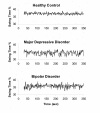Gait unsteadiness and fall risk in two affective disorders: a preliminary study
- PMID: 15563372
- PMCID: PMC538754
- DOI: 10.1186/1471-244X-4-39
Gait unsteadiness and fall risk in two affective disorders: a preliminary study
Abstract
Background: In older adults, depression has been associated with increased fall risk, but the reasons for this link are not fully clear. Given parallels between major depression and Parkinson's disease, we hypothesized that major depression and related affective disorders would be associated with impairment in the ability to regulate the stride-to-stride fluctuations in gait cycle timing.
Methods: We measured stride-to-stride fluctuations of patients with two forms of mood disorders, unipolar major depressive disorder (MDD) and bipolar disorder, and compared their gait to that of a healthy control group. The primary outcomes were two measures of gait unsteadiness that have been associated with fall risk: stride time variability and swing time variability.
Results: Compared to the control group, the two patient groups tended to walk more slowly and with decreased swing time and increased stride time. However, none of these differences was statistically significant. Compared to the control group, swing time variability was significantly larger in the subjects with bipolar disorder (p < 0.0001) and in the subjects with MDD (p < 0.0004).
Conclusions: Patients with MDD and patients with bipolar disorder display gait unsteadiness. This perturbation in gait may provide a mechanistic link connecting depression and falls. The present findings also suggest the possibility that measurement of variability of gait may provide a readily quantifiable objective approach to monitoring depression and related affective disorders.
Figures

Similar articles
-
Impact of depression on gait variability in Parkinson's disease.Clin Neurol Neurosurg. 2021 Jan;200:106324. doi: 10.1016/j.clineuro.2020.106324. Epub 2020 Oct 21. Clin Neurol Neurosurg. 2021. PMID: 33129594
-
Dual-tasking gait variability and cognition in late-life depression.Int J Geriatr Psychiatry. 2015 Nov;30(11):1120-8. doi: 10.1002/gps.4340. Epub 2015 Aug 6. Int J Geriatr Psychiatry. 2015. PMID: 26251013
-
Dual-tasking effects on gait variability: the role of aging, falls, and executive function.Mov Disord. 2006 Jul;21(7):950-7. doi: 10.1002/mds.20848. Mov Disord. 2006. PMID: 16541455
-
Gait dynamics, fractals and falls: finding meaning in the stride-to-stride fluctuations of human walking.Hum Mov Sci. 2007 Aug;26(4):555-89. doi: 10.1016/j.humov.2007.05.003. Epub 2007 Jul 5. Hum Mov Sci. 2007. PMID: 17618701 Free PMC article. Review.
-
[Gait disorders and falls from the neurologic viewpoint. 2. Clinical aspects].Z Gerontol Geriatr. 1997 Jul-Aug;30(4):263-6. Z Gerontol Geriatr. 1997. PMID: 9410504 Review. German.
Cited by
-
Managing variability in the summary and comparison of gait data.J Neuroeng Rehabil. 2005 Jul 29;2:22. doi: 10.1186/1743-0003-2-22. J Neuroeng Rehabil. 2005. PMID: 16053523 Free PMC article.
-
Detecting Depression Through Gait Data: Examining the Contribution of Gait Features in Recognizing Depression.Front Psychiatry. 2021 May 7;12:661213. doi: 10.3389/fpsyt.2021.661213. eCollection 2021. Front Psychiatry. 2021. PMID: 34025483 Free PMC article.
-
Unintentional Injuries among Psychiatric Outpatients with Major Depressive Disorder.PLoS One. 2016 Dec 16;11(12):e0168202. doi: 10.1371/journal.pone.0168202. eCollection 2016. PLoS One. 2016. PMID: 27992483 Free PMC article.
-
Walking on the bright side: Associations between affect, depression, and gait.PLoS One. 2021 Dec 2;16(12):e0260893. doi: 10.1371/journal.pone.0260893. eCollection 2021. PLoS One. 2021. PMID: 34855876 Free PMC article.
-
Unsteady walking as a symptom in type 2 diabetes mellitus: independent association with depression and sedentary lifestyle and no association with diabetic neuropathy.Braz J Med Biol Res. 2018 Mar 26;51(5):e6605. doi: 10.1590/1414-431X20186605. Braz J Med Biol Res. 2018. PMID: 29590256 Free PMC article.
References
-
- Bergland A, Jarnlo GB, Laake K. Predictors of falls in the elderly by location. Aging Clin Exp Res. 2003;15:43–50. - PubMed
Publication types
MeSH terms
Grants and funding
LinkOut - more resources
Full Text Sources
Medical

